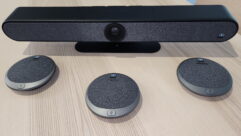A game of numbers
Apr 1, 1999 12:00 PM,
Joe Brusi
Loudspeaker directivity is expressed in many different ways on spec sheetsand marketing materials provided by loudspeaker manufacturers. Until thereis a benchmark for expressing this data, it will continue to be difficultto compare products produced by companies who use varying methods ofquantifying loudspeaker performance. This article will offer an explanationof thesemethods, thereby allowing you to make a more informed decision whenspecifying equipment.
Measuring directivityComplete directivity measurements start with the measurement of the soundpressure level (SPL) at all points on a sphere surrounding the loudspeakersystem. In other words, the loudspeaker is at the center of that sphere,and the distance between the loudspeaker and the surface of this spherewould be equal at all points and should be large when compared to theloudspeaker’s dimensions. The setup for this type of measurement is shownin Figure 1. These measurements are made at all frequencies, therebyallowing us to ascertain the frequency response at any angle. Thismeasurement is typically determined by placing a mic at a practicaldistance-around 13 ft (4 m)-and then rotating the loudspeaker to achievethe different angles. Most often, this rotation happens around one axis,thus necessitating two measurements-one for the vertical and one for thehorizontal, in between which the loudspeaker is manually rotated. The mostsophisticated systems can rotate around two axes so that all points of thesphere can be measured in the same run. The two-axis method provides notonly vertical and horizontal polar plots, but also the polars at obliqueangles as well.
The end result is a set of frequency response curves for each point of themeasurement sphere with resolution anywhere from 1/24-octave to 1/3-octaveand angular intervals anywhere from 1degrees to 10degrees. A set of thesefor the horizontal slice can be plotted as a waterfall display (see Figure2), where the high-resolution data shows the transition from a flat on-axisfrequency response (0degrees) to a response dominated by bass frequenciesbehind the cabinet (180degrees). One way to visualize the measurementpoints is as the equator on a globe.
When the SPL at all points of the sphere is plotted in 3-D for a givenfrequency, we get what is commonly referred to as the directivity balloon.The reasons for that name are clear when we see Figure 3. The plot lookslopsided-like a squashed balloon-because it is displaying the effects of ahorn that provides narrower dispersion vertically than horizontally. Wewill use the most common loudspeaker configuration in professional soundreinforcement, a two-way 15 inch (381 mm) cabinet, as the primary example.
If we divide the measurement sphere into slices, we end up with a set ofpolar plots, the result of 360degrees rotation around one axis. Thehorizontal polar would be similar to walking around a loudspeaker placed onthe floor. Only vertical and horizontal polar plots are customarilyincluded in spec sheets. An example of these can be seen in Figure 4.
If we join all the points where the level is the same on the measurementsphere, we end up with an isobar plot. Figure 5 shows a plot with -3 dB, -6dB, and -9 dB isobars.
The coverage angle is defined as the angle enclosed by the -6 dB points ona loudspeaker polar plot. The -6 dB point is used to avoid overlap when anumber of sources are splayed. Ideally, having the splay angle betweenadjacent boxes within an array the same as the coverage angle of a singlebox, resulting in seamless coverage between loudspeaker systems.
There is some disagreement among spec writers as to what the 0 dB referencein the calculation of the coverage angle should be. Some manufacturers takethe on-axis level, and some use the maximum output level exhibited on thepolar. If the polar is smooth, both references will be the same, but suchirregular responses as those measured from horns at high frequencies andthose in the crossover regions of multi-way passive crossovers usuallycause significant differences.
Figure 4 shows graphically how the coverage angle is calculated. In thiscase, we have about an 80degrees x 35degrees pattern for the 6.3 kHz1/3-octave band polar shown. Vertical and horizontal coverage angles withfrequency can be seen in Figure 6. This two-way system has a 360degreescoverage at low frequencies, which gradually decreases until the crossoverfrequency where the horn and driver take over to achieve fairly constant coverageup to 16 kHz. Both graphs reflect the same set of data, but the top oneuses a linear vertical scale while the bottom one uses a logarithmic scale.The latter tends to be the most common, and it reveals the horn’sperformance a bit better visually. Because the coverage angle varies withfrequency, spec sheets normally provide a value that has been averaged overa specified frequency range, typically that of the high-frequency horn.This value often conforms to nominal values, such as 90degrees, 60degreesor 40degrees. Our example loudspeaker would most likely be rated as a90degrees x60degrees (horizontal x vertical) system.
The Q factor is a mathematical expression indicating directionality of thesource. Larger Q factor values denote more directional sources. The Qfactor is calculated by comparing the on-axis level with the average levelfor all the points in the measurement sphere. In practice, Q is oftenderived from the horizontal and vertical polar plots. A spherical source (asource that has the same output level at all angles, close to a subwooferat low frequencies) has a Q factor of 1. A hemispherical source,essentially a sphere that is placed against a wall (this condition isreferred to as 2p or half space), has a Q of 2. As with coverage angle,different evaluation methods are used, which can generate slightlydifferent Q results. A more detailed explanation of the Q factor can befound in a number of books dealing with loudspeaker systems. I recommendGlen Ballou’s New Audio Cyclopedia as a quick reference.
The directivity index (DI) is the same as Q factor, but expressed in alogarithmic fashion: DI (in dB)=10log Q. Thus, a spherical source has a Qfactor of 1 and a directivity factor of 0 dB, and a hemispherical sourcehas a Q factor of 2 and a directivity factor of 3 dB. Typical directivityindexes for a horn would range from 10 dB to 20 dB, corresponding to Qfactors of 10 to 100. The DI for the polar plots represented in Figure 4 is12 dB (Q factor of 16). On-axis sensitivity and DI have a directcorrelation. Using a subwoofer as an example, when it is placed against awall, it will increase in sensitivity by 3 dB (DI will change from 0 to 3dB, Q factor from 1 to 2) as compared to its free-field sensitivity. Figure7 shows the DI and Q with frequency for the example two-way system. We cansee a rising response from the 15 inch (381 mm) woofer, which correspondsto the narrowing of the cone’s directivity (or beaming) as frequencyincreases. In contrast, the directivity that the horn exhibits is fairlyconstant with frequency, commonly referred to as a constant directivity(CD) horn. DI (Q) and coverage angles are typically plotted for 1/3-octavebands.
It is increasingly common for manufacturers to provide off-axis frequencyresponse measurements on their data sheets. These measurements are madegenerally at intervals of 10degrees or 15degrees off-axis from the directon-axis 0degrees, 0 dB measurement. Generally, spec sheets show plots ofonly one vertical and one horizontal set of measurements. A bit moreinsight is provided by data that show multiple intervals left and right(horizontal) in off-axis response and up and down (vertical) off-axisresponse on the specification sheets to show the asymmetrical response ofthe device in question. Vertical and horizontal relative frequencyresponses in 15degrees intervals (0degrees, 15degrees, 30degrees and45degrees) can be seen in Figure 8 for the example loudspeaker.
When examining these off-axis frequency responses, it is important torealize that they are relative, which means that the 0degrees responsewould be a straight line going through 0 dB, since it has become thereference for the other responses. If we were able to equalize theloudspeaker flat at 0degrees, these would be our frequency responses at thespecified angles.
In order to represent all measured data for all frequencies, some fairlycomplex plots are required. Another isobaric display can be seen in Figure9, where we have measurement angle as a function of frequency. In thiscase, isobars are plotted in 1 dB increments from 0 dB to 6 dB. The latterwould represent the coverage angle. The flat portion of the isobars in the2 kHz to 16 kHz region shows the constant directivity nature of the horn inthis system.
Electro-acoustic modeling software such as EASE from Renkus-Heinz, JBL’sCADP2 and Bose’s Modeler can be used to display directivity informationquite effectively. These programs use fairly crude directivity balloonstypically with 10degrees resolution in octave bands. Lately, the AES hasbeen trying to standardize directivity data for use in modeling softwareand increasing data resolution for more accuracy in the predictions thatthe programs can provide.
The projection of the loudspeaker’s directivity onto a coverage area can beseen for EASE and CADP2 in Figures 10 and 11 respectively. These plots areexcellent for showing graphically a great deal of information for technicaland non-technical people. When a non-technical customer can visualize thisinformation on the modeling software, it creates the understandingnecessary to get design ideas across, close the sale and seal theinstallation of a system for your customer.










